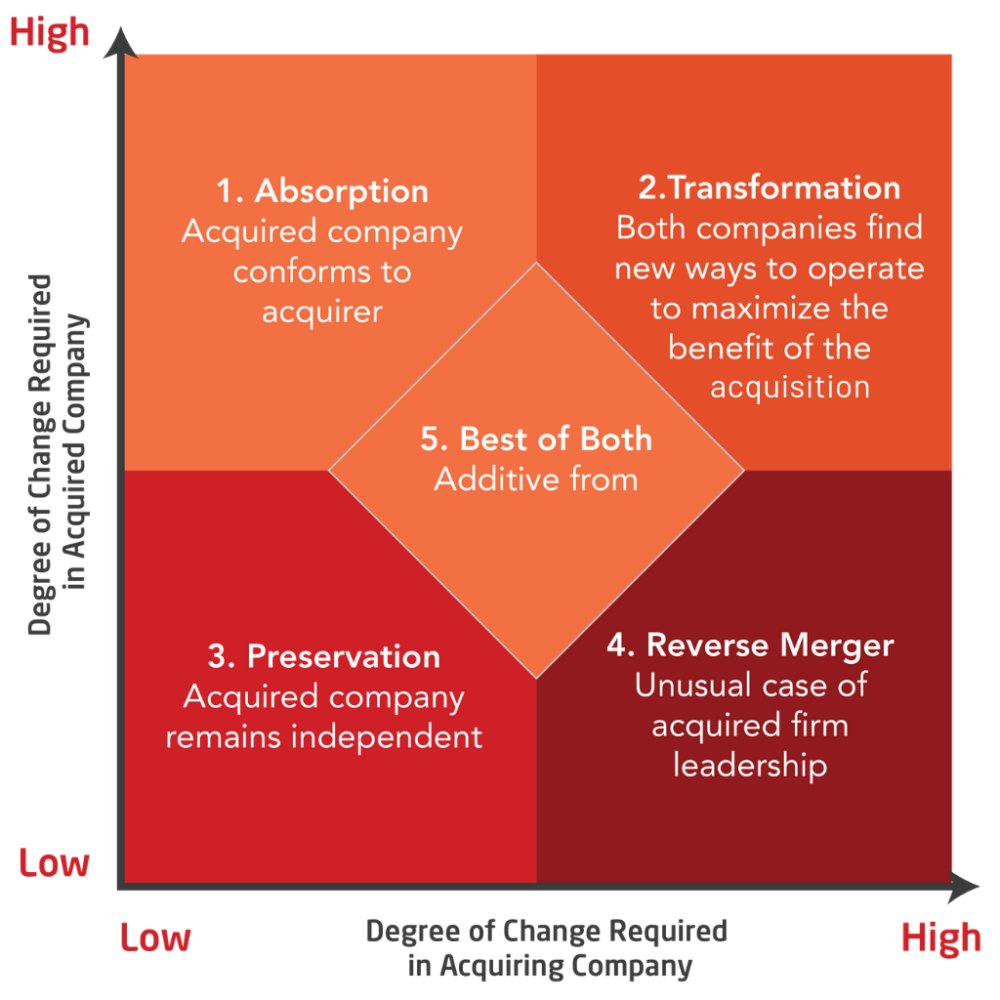Best Practices for a Business Integration Strategy
M&As deal come with a great amount of expectation for growth potential and profits. However, M&A deals also come with their own set of challenges. We’re here to offer best practices for a business integration strategy, which may differ depending on whether horizontal integration or vertical integration occurs.
After the deal is over, the real challenge of orchestrating a complete organization redesign begins. It’s obvious that there isn’t an easy way of pasting one enterprise within another. Even so, many companies fail to consider all the factors that require assessment before joining two groups. This is why the majority of mergers and acquisitions never achieve desired synergies or performance value three years post-acquisition.
Not All Acquisitions Are the Same
A main reason is due to suboptimal operational integration. For instance, even though an app development company may acquire another app group, the business models may be vastly different. What we typically see as horizontal integration can actually become much more complex based on how much the operating models differ. Despite wanting a clean and easy integration, folding one company under the wing of the other generally only provides immediate efficiencies, not long term pay off. Remember that you can’t jam a square peg into a round hole.
Vertical integration also comes with its own set of obstacles. Two companies that vary in purpose will require a learning curve on both sides to understand how the businesses can best work together. The real work happens when a current state review is completed to highlight each individual business, similar aspects, and unique aspects.
Since many mergers & acquisitions can be cumbersome projects that take time and resources to finalize, we can see the fatigue setting in before the companies are even joined together. In reality, this is the most crucial point in any business integration and it’s these challenges that highlight the vital need to think holistically, not just horizontally or vertically.
Before diving into the change management process post-merger, senior executives and the design team must create a blueprint to outline action. A well thought-out business integration strategy assists leaders in hitting their transformation targets and integration objectives.
How much change is required?
The first step is to identify how much change will have to happen to fully integrate the businesses and whether that change happens through horizontal integration or in a vertical fashion. This allows you to identify potential challenges before they arise, giving a better idea of how to proceed in creating a strategy. Both the acquiring company and acquired company will ultimately need to undergo a certain level of change. This is true of both vertical and horizontal integration.
Tips for creating a seamless business integration strategy
Our experienced team of organization design consultants share some of their best advice for approaching integrations.
1. Mobilize all involved employees, not just leadership
Organizations don’t change, people do! Mergers and Integration are essentially about creation of additional value or, somehow improving efficiencies. The mistake that often happens is the business integration strategy is treated as a technical issue only. There can be no integration that improves performance unless the organization’s people are directly involved in the process. – Wilma Paxton Doherty, Senior Consultant
2. Focus on how people work together, not just what they do
When it comes to integration, companies need to focus on how people work together as much as they think about what tasks people do. An integration activity is really about building social capital together; we are integrating communities, not machines. – Dan Schmitz, Consultant
3. Involve both organizations in the design
The common mistake organizations make is approaching mergers as one side taking over the other. This is an unhelpful and unproductive mode of thinking. You need to involve both sides in the design of the new integrated structure. Don’t make the mistake of trying to ‘integrate’ one into the other. Remember, once the deal is done it’s about integration, not merger or acquisition. – Peter Turgoose, Former Senior Consultant
4. Start with a solid plan
Three actions to predict success with a business integration strategy are:
- Start fast and way upstream with assessing fit first.
- Set a clear integration strategy and outcomes.
- Ensure behavioral integration and change. Behavioral change is at the individual, group and organizational levels. Meanwhile, integration is as much about the social system as it is about the technical.
– Mark LaScola, Founder & Managing Principal
What comes next?
Successful mergers and acquisitions call for visionary leadership that marries a changing strategy, competitive difference, products and services, and customers into a business integration strategy. When done right, the implementation leads to new sources of value that validate the M&A. This payoff is invaluable.
OTM’s methodologies work to support your acquisition strategy, integration objectives, and reaching your overall transformation target. We understand the unique challenges that arise for horizontal integration and vertical integration and will collaborate closely with your team. Learn more about how our solutions can help facilitate your business integration.
OTM is the leading global boutique organization design consultancy with offices in the USA and UK. With over 450 successful redesigns and operating model modernizations completed, OTM is the owner of the industry’s most integrated, comprehensive, and holistic organization design solution. OTM enables its clients to realize their future ambitions.



